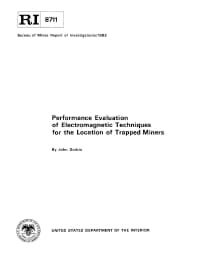Mining Publication: Performance Evaluation of Electromagnetic Techniques for the Location of Trapped Miners
Original creation date: January 1982
Authors: JA Durkin
NIOSHTIC2 Number: 10002571
U.S. Department of the Interior, Bureau of Mines. Report of Investigations 8711, NTIS PB83-144600, 1982; :1-35
The Bureau of Mines (NIOSH Mining) has conducted field studies in coal mines throughout the United States to determine the effectiveness of electromagnetic techniques in locating miners trapped underground following a mine accident. Data from these tests have been used to generate models of expected signal and noise distributions as found above mines throughout the coalfields. These distributions have aided in placing the expected performance of a through-the-earth electromagnetic communications technique into a probabilistic framework. Results show that at a 10 percent false alarm rate, the expected probability of detecting a miners signal from a depth of 1,000 ft is 54 percent; at 500 ft it is 95 percent. These depths exceed the actual depths of 90 percent and 50 percent, respectively, of U.S. coal mines. Sensitivity studies have shown that at a depth of 1,000 ft, for every 3 db of improvement in signal-to-noise ratio, the probability of detection increases 6 to 8 percent.

NIOSHTIC2 Number: 10002571
U.S. Department of the Interior, Bureau of Mines. Report of Investigations 8711, NTIS PB83-144600, 1982; :1-35
- Adaptive-Noise-Cancellation Techniques for Through-the-Earth Electromagnetics: Volume III
- Assessment of Present Electromagnetic Techniques for the Location of Trapped Miners
- Basic Tutorial on Wireless Communication and Electronic Tracking: Technology Overview
- Communication Systems Research At Bruceton Safety Research Mine
- Development of a Through-the-Earth Monitor System
- Emergency Communications and Tracking
- NIOSH-Sponsored Research in Through-the-Earth Communications for Mines: A Status Report
- Propagation of EM Signals in Underground Mines
- Technology News 544 - New Measurement Tool to Validate Wireless Communications and Tracking Radio Signal Coverage in Mines
- Through-The-Earth Wireless Real-Time Two-Way Voice Communications